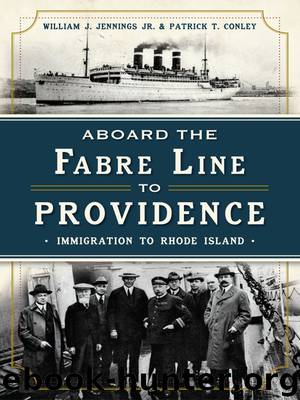Aboard the Fabre Line to Providence by Patrick T. Conley

Author:Patrick T. Conley
Language: eng
Format: epub
Publisher: The History Press
Published: 2013-03-14T16:00:00+00:00
First-class tourists were given Fabre Line fans to ward off the heat during stops on the North African Coast and in the Near East. This souvenir item is a part of the Conley Collection of Fabre Line memorabilia. Conley Collection.
At the same time that the company was attempting to secure its portion of the tourist traffic to Europe and the Middle East, it made known its intention to receive a greater quantity of cargo at the port of Providence.164 Even at this late date, the company had not given up its longtime desire to make Providence an important cargo-handling port. Although it is unlikely that Fabre still entertained the idea that Providence might replace New York as its major terminal, the company believed that the port could cater to the needs of southern New England more effectively.
Because of the general decline of immigrant passengers, Fabre clearly had to expand in other areas if it was to remain at Providence. This appears to be the underlying reason for the line’s efforts toward tourism and further cargo handling. From passenger statistics contained in the Annual Report of the Commissioner General of Immigration, as well as the absence of much notice pertaining to tourism in the Providence Journal, it is apparent that the line failed to develop its tourism trade to any marked degree. Nevertheless, the bigger and newer ships of the line continued to call at Providence until July 1934. In conjunction with its attempts to increase cargo handling at the port, the Fabre Line opened an office on the second floor of the state pier in June 1928. Theophilus Hamlin was appointed the line’s baggage master and freight clerk at the port, with duties that also included the promotion of passenger traffic.165
During May 1928, the Roma, an old veteran of the Providence run and the only Fabre steamer to call at the port during the dangerous years of World War I, made its final arrival and departure. Later in the year, it was scrapped at the French Mediterranean port of LaSeyne. To replace the Roma, the Fabre Line purchased the Montreal from the Canadian Pacific Railroad’s steamship company and renamed it Alesia. The accommodations of the new vessel were much more modern than those of the Roma, and it was hailed as a vast improvement for the line.166
When the Sinaia arrived at Providence in September 1928, the Journal reported an interesting cultural development: Turkish women had come from their homeland without being heavily veiled. In that year, the political leader of Turkey, reformer Kemal Pasha (later known as Ataturk), had thrust aside the century-old custom that required native women be so attired. The Sinaia carried several young Turkish men and women to America who were said to have been enrolled in postgraduate courses in American universities.167
During the spring of 1930, the Fabre Line lost its steamer Asia. Recently transferred from the Mediterranean-American run to the Mediterranean-African run, the vessel was destroyed by fire on the Red Sea coast of Saudi Arabia in May 1930 while transporting religious pilgrims to the holy city of Mecca.
Download
This site does not store any files on its server. We only index and link to content provided by other sites. Please contact the content providers to delete copyright contents if any and email us, we'll remove relevant links or contents immediately.
Cecilia; Or, Memoirs of an Heiress — Volume 1 by Fanny Burney(31336)
Cecilia; Or, Memoirs of an Heiress — Volume 3 by Fanny Burney(30935)
Cecilia; Or, Memoirs of an Heiress — Volume 2 by Fanny Burney(30891)
The Great Music City by Andrea Baker(21381)
We're Going to Need More Wine by Gabrielle Union(18075)
Bombshells: Glamour Girls of a Lifetime by Sullivan Steve(13113)
Pimp by Iceberg Slim(12935)
All the Missing Girls by Megan Miranda(12755)
Fifty Shades Freed by E L James(12452)
Talking to Strangers by Malcolm Gladwell(11887)
Norse Mythology by Gaiman Neil(11886)
Crazy Rich Asians by Kevin Kwan(8352)
Mindhunter: Inside the FBI's Elite Serial Crime Unit by John E. Douglas & Mark Olshaker(7838)
The Lost Art of Listening by Michael P. Nichols(6475)
Enlightenment Now: The Case for Reason, Science, Humanism, and Progress by Steven Pinker(6407)
Bad Blood by John Carreyrou(5773)
The Four Agreements by Don Miguel Ruiz(5512)
Weapons of Math Destruction by Cathy O'Neil(5039)
We Need to Talk by Celeste Headlee(4872)
